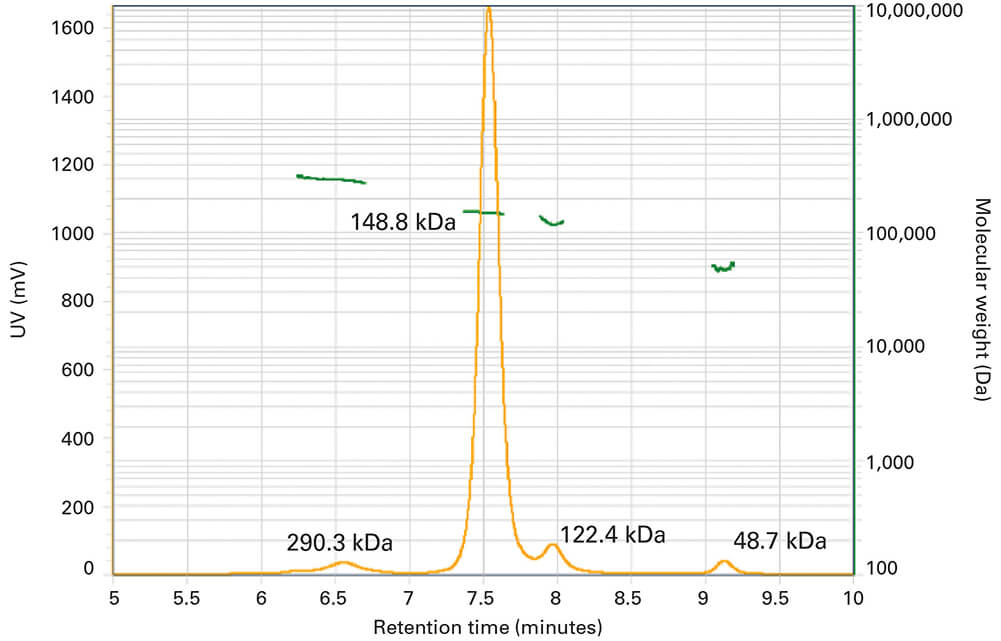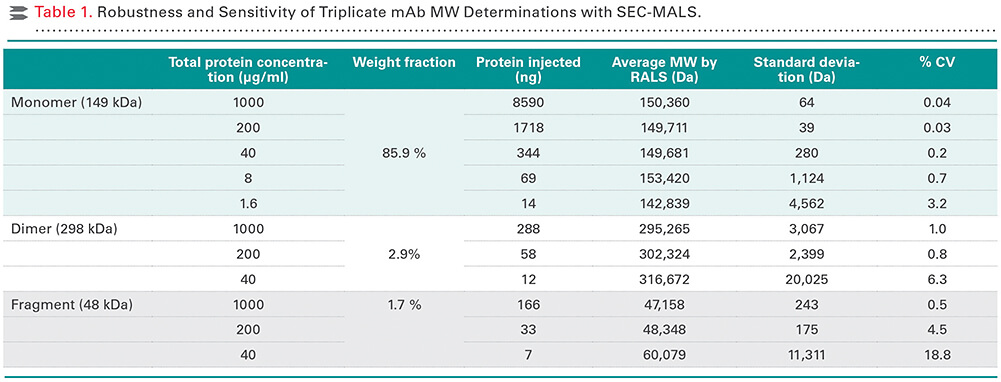A reference mAb was used to demonstrate the benefits of multiangle light scattering detection combined with size exclusion analysis of a monoclonal antibody. Adaptations were required to optimize MALS data quality as light scattering is more sensitive for particles such as salt crystals, microbes or column shedding than UV detection: the mobile phase was filtered twice and a light-scattering dedicated UHPLC column (TSKgel UP-SW3000-LS) was employed. It had previously demonstrated lowest noise levels in a comparison with two other columns; and the LenS3 MALS detector was chosen due to its high sensitivity in order to check the stability of the method also for low abundance impurities.
- Column: TSKgel® UP-SW3000-LS 2 μm,4.6 mm ID x 30 cm L (P/N 0023546)
- Mobile phase: 100 mmol/L NaH2PO4 Na2HPO4, pH 6.7, 100 mmol/L, Na2SO4 (filtered twice using a 0.1 μm pore size PES vacuum filter)
- Flow rate: 0.35 ml/min
- Detection: UV-absorbance @280 nm, Multi-angle light scattering with LenS3 (RALS for MW)
- Injection vol.: 10 μl
- Sample: SILu™Lite SigmaMAb (1 mg/ml), IgG1 monoclonal antibody standard (Sigma #MSQC4)
- Instrument: Thermo Scientific Vanquish UHPLC
Results
The MW of monoclonal antibody and its impurities was analyzed using UV280 as a concentration detector and the right angle light scattering signal (RALS) for MW calculation This way impurities with 290.3 kDa (dimer), 148.8 kDa (monomer), 122.4 kDa (mAb missing one light chain) and 48.7 kDa (Fab fragment or two aggregated light chains) (Figure 1). For sensitivity and robustness determination, triplicate injections of a dilution series of the antibody were analyzed. Accurate and robust results were achieved down to 50 ng injected protein, while at lower concentrations, MW determinations were still possible but with lower accuracy and higher variation.
Conclusion
Analyzing monoclonal antibody samples with SEC-MALS directly determines the MW of sample components. This facilitates the assignment of peaks to the structures of impurities. Employing the sensitive LenS3 MALS detector in combination with the light-scattering dedicated UP-SW3000-LS column, the method is sensitive down to less than 50 ng of dimerized antibody. However, MW determination of monomer and impurities is possible at concentrations down to 15 ng but with less accuracy and higher variation.
www.tosohbioscience.de







